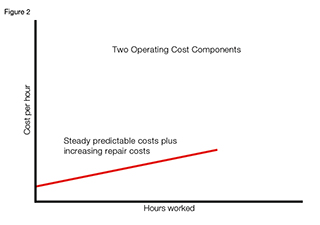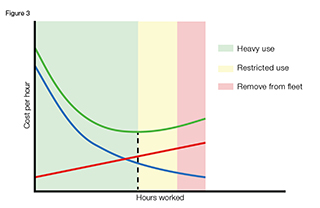|
Subscribe / Renew |
|
|
Contact Us |
|
| ► Subscribe to our Free Weekly Newsletter | |
| home | Welcome, sign in or click here to subscribe. | login |
Construction
| |
 |
May 2, 2013
Sharp equipment managers use decision points
Dexter + Chaney

Newitts
|
In these days of tight construction budgets, everyone is looking for ways to control costs. But when it comes to managing the costs of buying, operating and maintaining a fleet of equipment, construction companies often find themselves keeping track of two different sets of expenses.
Executives or managers in the office, such as the CFO or purchasing manager, are typically responsible for investment and ownership costs for the company fleet. But once equipment is deployed, the costs of operation and maintenance fall to project managers and equipment managers who supervise daily use at construction job sites.
In tracking costs, executives and equipment managers usually work separately towards the same goal: To keep overall vehicle costs down as much as possible. But the best equipment managers take it one step further. They combine and compare ownership and operating costs to establish a total cost of ownership for each vehicle. This helps to effectively manage costs over time, while also getting as much value as possible out of each vehicle over its lifespan.
If you chart the combined ownership and operating costs of each construction vehicle over its life cycle, you’ll find a point at which the total cost-per-hour of owning and operating that vehicle starts to go up instead of down. This decision point represents the moment that the vehicle begins to lose its value to your company — that is, it starts on the path to becoming more of a liability than an asset.
But once you know where that point lies for any particular type of equipment, you can use it as a benchmark. It can help you to make smarter decisions on how and where to spend money on your fleet of construction vehicles.
Tracking costs
The first step in finding the decision point is to document all your ownership and operating costs for each vehicle in your fleet. The sooner you start doing this, the sooner you will build a picture of total costs over time. Not only will this help you manage equipment investment, it will help you accurately determine how much each construction job should be charged for the use of each piece of heavy equipment.
If you don’t already have one in place, you should implement a policy to record all equipment expenses, both capital and operational. Make sure your employees know that documenting these costs is an ongoing requirement, and provide them with the tools they need to quickly and easily capture this information. There are a number of software applications, including apps for use on mobile devices that can help streamline this process.
Ownership costs
There’s an old maxim that the value of a new vehicle starts to decrease the second the front tires leave the lot. That’s certainly true of construction equipment. But depreciation, or loss of value, is just the beginning of what you should take into account when you consider the cost of ownership. You should also include (and document) licensing, insurance, interest on payments, and the property taxes associated with owning a fleet of vehicles.
The residual value of a vehicle — the amount you can recover through re-sale — is perhaps the single most relevant figure in calculating your ownership cost. The difference between purchase price and an ever-changing resale price determines the shape of the owning cost curve over time. As time goes on, you can recover less by selling the equipment, so the opportunity cost of keeping a machine in your fleet actually goes down. Of course, with fixed costs such as insurance and licensing, the curve will not reach zero.
Operating costs
It should be no surprise that the costs of operation for construction vehicles go up over time. As equipment ages, it becomes less efficient and more prone to failure. Repairs become more frequent, and you can even predict the acceleration of wearable part replacement with a fair degree of accuracy.
In general, you can model the rate of operating costs for construction vehicles by combining a steady rate of (mostly) predictable costs such as fuel, oil and preventive maintenance with the increasing rate of repair costs.
The specific values for both the predictable and variable costs will vary for different types of heavy equipment and the way different companies use and maintain their equipment. But you can determine these rates for your own company by regularly recording field measurements of all major operating costs for each vehicle you own.
The whole picture
If you are responsible for construction equipment, you know that you should make purchases or leases under the best terms possible, and schedule vehicles for appropriate use and adequate maintenance. But even when this happens, one question remains: “How long should we keep each vehicle in our fleet?”
To answer this question, you must do two things: Manage costs over time, and look at the combination of owning and operating costs. Total costs initially decrease over time due to the dominance of decreasing costs of ownership. But as this decrease levels off, the effects of ever-increasing operating costs take over and the marginal cost of equipment use starts to rise.
Where the total cost curve flattens out defines a decision point. Not necessarily the point at which a piece of equipment should be taken out of service and sold, but a point at which that equipment should be flagged for careful monitoring, its usage reduced and consideration given for eventual re-sale.
In addition to informing decisions on individual pieces of equipment, consistently performing cost-over-time analysis will reveal trends that help you better manage your entire fleet. You will create more accurate capital expense budgets because you will know when to expect different equipment types to outlive their economic lives.
With a little effort, you can correlate operating costs to different operating conditions. If you know how operating costs vary based on the types of jobs worked, types of parts used, or even which operators run the equipment, you can better predict job costs and make better decisions toward improving construction operations and project profitability.
Wayne Newitts is director of marketing at Dexter + Chaney in Seattle.
Other Stories:
- Safety's role in the ‘new normal’ of construction
- Health Care
- Commercial Construction
- Survey: Andersen Construction
- Demolition
- Specialty Construction (merit award)
- Survey: S.D. Deacon
- Survey: Lease Crutcher Lewis
- Survey: Skanska USA
- Survey: Express Construction Co.
- Survey: PCL Construction Services
- Electrical & Communications
- Mechanical Construction
- Mixed-Use Construction
- ‘Big Room’ streamlines collaboration, communication
- Technology moves construction projects off the paper trail
- Going modular? Think of the factory as a big subcontractor
- Sick leave, pot laws leave employers feeling queasy
- Making sense of construction cost audits
- Is your insurance broker a claims advocate?
- Avoid the pitfalls of transition planning
- Eagle of Excellence Award • Tenant Improvement/Renovation
- Eagle of Merit Award • Specialty Construction
- Institutional
- Survey: Rider Levett Bucknall





